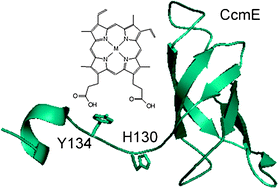Metal and redox selectivity of protoporphyrin binding to the heme chaperone CcmE†
Abstract
The interaction of

- This article is part of the themed collection: Cytochromes
Maintenance work is planned for Wednesday 1st May 2024 from 9:00am to 11:00am (BST).
During this time, the performance of our website may be affected - searches may run slowly and some pages may be temporarily unavailable. If this happens, please try refreshing your web browser or try waiting two to three minutes before trying again.
We apologise for any inconvenience this might cause and thank you for your patience.
a
Department of Biochemistry, University of Oxford, South Parks Road, Oxford, United Kingdom
E-mail:
stuart.ferguson@bioch.ox.ac.uk
Fax: +44 (0) 1865 275259
b Department of Chemistry, University of Cambridge, Lensfield Road, Cambridge, United Kingdom
The interaction of

 Please wait while we load your content...
Something went wrong. Try again?
Please wait while we load your content...
Something went wrong. Try again?
 Fetching data from CrossRef.
Fetching data from CrossRef.
This may take some time to load.
Loading related content
